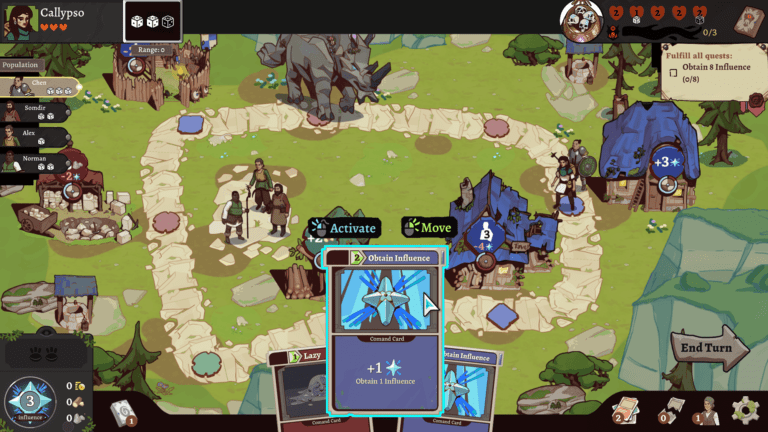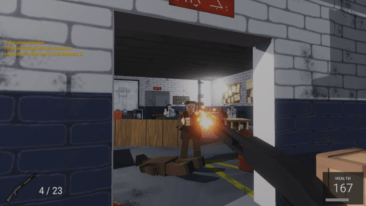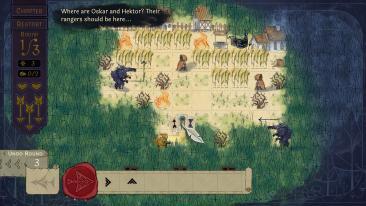Demon Loop by Magnolia Games
Demon Loop, developed by Magnolia Games, wraps confusion, bad grammar and spelling, and frustration into one exclusive package.
My experience with Demon Loop presented a rollercoaster of emotions as I battled through this digital board game.
What’s the Scoop on Demon Loop?
Though I’ve only mustered through the demo, I was constantly questioning what I was doing and deciphering the gameplay by mini-strokes of luck. Even after crawling to the finish line, I’m still scratching my head.
As the demo commences, Maester Opal presents a poorly delivered synopsis to Callypso, the protagonist, regarding his adventure. Callypso is granted the role of protecting the humans from monsters.
Personally, it was challenging to ignore very obvious spelling errors on top of grammatical mishaps. However, I did my best to not seethe at them, seeing as dialogue and storytelling isn’t a key feature of Demon Loop.
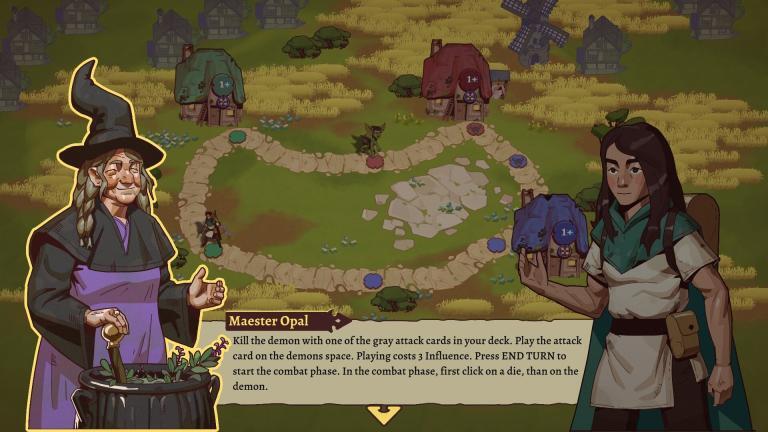
The first quest of the demo involves gaining Influence, which becomes useful when wanting to play certain cards. As previously mentioned, Demon Loop presents as a digital board game accompanied by deck-building and turn-based combat. The design is simple enough, and the cartoon visuals and cutesy animations complement the light-hearted gameplay well.
Lost in the Loop
Though the atmosphere is charming, it doesn’t make up for the fact that novice players are bound to flounder. I’m not very chummy with deck-building games, so I was anticipating a tutorial of some sort. Nothing wrong with some hand-holding through fundamental game mechanics.
Maester Opal does offer a quick run-down of Demon Loop’s rules, but failure seemed to be how I learned best. As stated, one of Demon Loop’s main mechanisms centers around deck-building capabilities. Identifying the stats on a card involves knowing to access the Settings menu and read about it. Otherwise, you’re kind of flying by the seat of your pants.
Demon Loop also integrates strategy as a core component. It’s vital to understand the importance of devising the use of the playable cards in your hand. At the end of each turn, the cards get shuffled back into your deck and randomly chosen at the beginning of the next round.
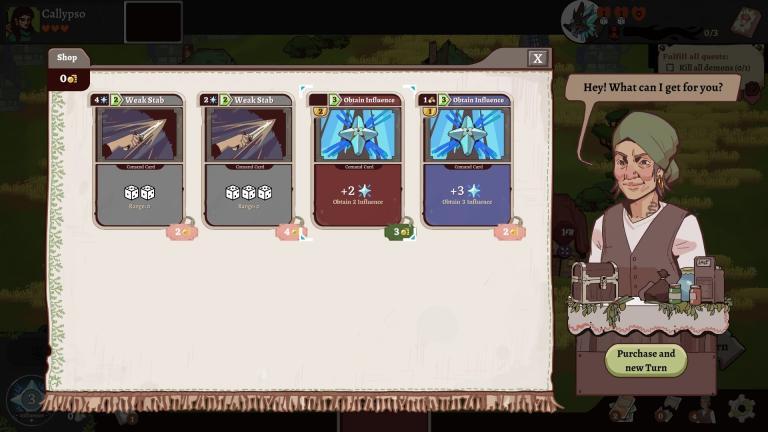
Most cards can be utilized to move Callypso a set number of spaces across the board. Additionally, some cards are played to gain Influence, confront enemies, repair buildings, and other important features. Using certain cards depends on which color Callypso lands on, too.
I learned to be very deliberate and cautious playing Demon Loop. If you accidentally select a card, you must use it. There is no turning back. Eventually, more cards can be added to your deck by progressing or purchasing them at the Card Shop.
Demonic Difficulties
Encountering a demon has to be one of the most frustrating and unfair elements of Demon Loop. As the demon moves across the board utilizing impressively powerful cards, spaces are marked with a symbol determining the spaces the demon can reach. As a player, moving Callypso as far from the demon as possible became my strategy until Callypso rallied up enough Influence to use an attack card.
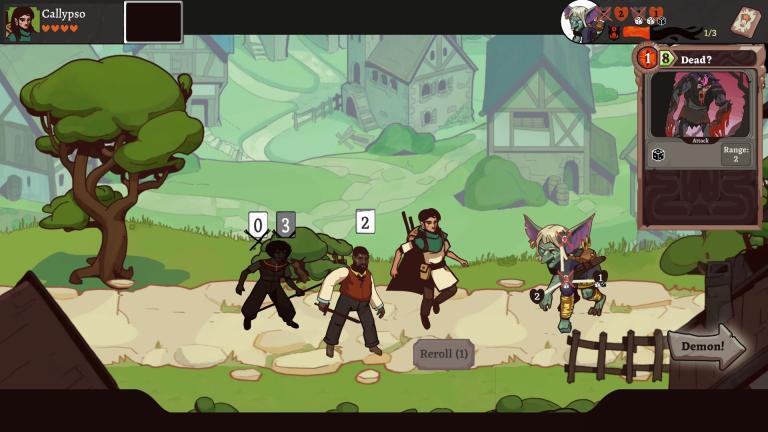
On each level I played, the demon could eventually land on ANY space at one point. If it happens to land on your space before you’re ready to land the first strike, you’re confronted by the demon. He also gets to use an extra die in combat.
Callypso only starts with three health points, while the demon can roll up to five hits (sometimes double if rolling two dice), completely obliterating Callypso.
My biggest gripe is Callypso doesn’t foster half the strength in his deck that a supposed “low-level” demon possesses. Countless times, I’d have to restart a level because the demon overpowered Callypso by an embarrassing amount.
Luckily, some stages don’t require you to kill the demon to succeed. Sometimes your quest might be to repair a building. Good luck avoiding the demon forever, though.
Villagers for Victory
On some levels, villagers await being recruited by Callypso. Each villager comes equipped with special features, i.e. extra dice with bigger numbers to wield during battle.
Villagers unlock depending on the level’s structure, and which villager accompanies Callypso is random each time. At one point, unlocking a villager to assist Callypso costs four Influence, which have to be acquired by landing on certain spaces or using specific Influence cards.
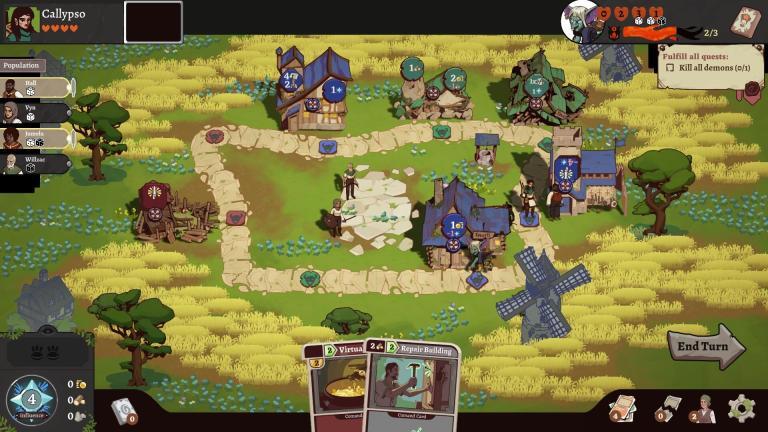
I found the villagers a useful and tactical part of my journey, making me less annoyed at Demon Loop. However, after a battle, they return to their base and must be recruited all over again.
Speaking of annoying, there is only one tune that plays on a loop for the entirety of the demo. For some reason, the music and sound effects are at a super low volume when you take the reins as Callypso, but they’re adjustable in the Settings. After hearing the same song over and over again, though, I decided to keep the volume at 0 for my own sanity.
Now I’m not saying all of Demon Loop is a headache. It could certainly be more of an enjoyable strategy experience with a few alterations.
I did revel in being tactical and kicking demon butt after I somewhat figured out an approach. The visuals were also delightful to my eyes. I’m not sure that quite makes up for the superior demons or deficiency of guidance, though.
Demon Loop will be available via Steam upon release.
Watch the trailer for Demon Loop below:

